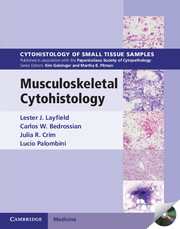Book contents
- Frontmatter
- Contents
- 1 Principles and practice for biopsy diagnosis and management of musculoskeletal lesions
- 2 Ancillary techniques useful in the evaluation and diagnosis of bone and soft tissue neoplasms
- 3 Spindle cell tumors of bone and soft tissue in infants and children
- 4 Spindle cell tumors of the musculoskeletal system characteristically occurring in adults
- 5 Giant cell tumors of the musculoskeletal system
- 6 Myxoid lesions of bone and soft tissue
- 7 Lipomatous tumors
- 8 Vascular tumors of bone and soft tissue
- 9 Pleomorphic sarcomas of bone and soft tissue
- 10 Osseous tumors of bone and soft tissue
- 11 Cartilaginous neoplasms of bone and soft tissue
- 12 Small round cell neoplasms of bone and soft tissue
- 13 Epithelioid and polygonal cell tumors of bone and soft tissue
- 14 Cystic lesions of bone and soft tissue
- Index
6 - Myxoid lesions of bone and soft tissue
Published online by Cambridge University Press: 05 September 2013
- Frontmatter
- Contents
- 1 Principles and practice for biopsy diagnosis and management of musculoskeletal lesions
- 2 Ancillary techniques useful in the evaluation and diagnosis of bone and soft tissue neoplasms
- 3 Spindle cell tumors of bone and soft tissue in infants and children
- 4 Spindle cell tumors of the musculoskeletal system characteristically occurring in adults
- 5 Giant cell tumors of the musculoskeletal system
- 6 Myxoid lesions of bone and soft tissue
- 7 Lipomatous tumors
- 8 Vascular tumors of bone and soft tissue
- 9 Pleomorphic sarcomas of bone and soft tissue
- 10 Osseous tumors of bone and soft tissue
- 11 Cartilaginous neoplasms of bone and soft tissue
- 12 Small round cell neoplasms of bone and soft tissue
- 13 Epithelioid and polygonal cell tumors of bone and soft tissue
- 14 Cystic lesions of bone and soft tissue
- Index
Summary
INTRODUCTION
A large number of lesions arising within bone and soft tissues may display a myxoid background. In most neoplasms, this is an uncommon phenomenon and is often only focal in distribution. However, a number of lesions consistently show a myxoid background dominating the histologic and cytologic appearance of the specimen. Myxoid change is a relatively infrequent occurrence in schwannomas and synovial sarcomas but, as the names imply, is a characteristic morphologic feature of myxomas, myxoid liposarcomas, myxoid chondrosarcomas, and examples of myxofibrosarcoma and fibromyxosarcoma. The presence of a prominent myxoid stroma frequently indicates a relatively slow growing neoplasm and has been inversely correlated with frequency of metastatic disease.
The nature of the myxoid material varies among lesions. In some cases, the myxoid phenomenon is degenerative as seen in ganglion cysts, while in other instances, the myxoid material appears to be a secretory product such as chondroitin sulphate in myxoid chondrosarcomas.
Morphologically, the myxoid matrix in these lesions is generally not helpful in their specific diagnosis. Vascular pattern, cell distribution, and degree of nuclear atypia are features allowing accurate diagnosis of these lesions. Molecular diagnostic features such as the presence of the t(12;16)(q13;p11) translocation in myxoliposarcomas, the t(9;22)(q22;q21) translocation in extraskeletal myxoid chondrosarcomas, and the t(7;16)(q33;p11) translocation in low grade fibromyxoid sarcomas are helpful diagnostic features.
- Type
- Chapter
- Information
- Musculoskeletal Cytohistology , pp. 114 - 139Publisher: Cambridge University PressPrint publication year: 2000



